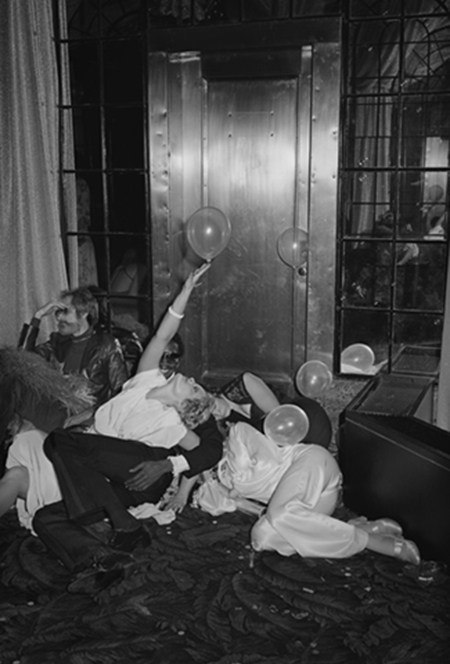
Yale University Art Gallery
Photographer Tod Papageorge, a former director of the Yale School of Art graduate program in photography, had been shooting photographs all night at New York City’s vaunted Studio 54 when he captured “New Year’s Eve, New York Discotheque,” now in the Yale University Art Gallery collection.
View full image

Yale University Art Gallery
Photographer Tod Papageorge, a former director of the Yale School of Art graduate program in photography, had been shooting photographs all night at New York City’s vaunted Studio 54 when he captured “New Year’s Eve, New York Discotheque,” now in the Yale University Art Gallery collection.
View full image
It’s easy to feel the Disco Era was pretty silly: the spinning mirror ball, polyester flares, the Village People. But the American economy was collapsing in the late 1970s, and the nation was on the verge of the AIDS epidemic and the rise of the Moral Majority. For that matter, the songs we danced to—I’m thinking of “Stayin’ Alive” by the Bee Gees, “I Will Survive” by Gloria Gaynor, and “Last Dance” by Donna Summer—suggest there was something serious at stake. And if it all seems long ago and irrelevant to the turmoil of our world today, recall that Donald Trump frequented Studio 54, and “YMCA” has become a MAGA anthem.
Tod Papageorge conveys the glare and intensity of the Disco Era in Studio 54, a book which collects 66 of the black and white photographs he took at the famous club, including this image of revelers at dawn on New Year’s Day 1978. Papageorge was director of graduate studies in photography at Yale from 1979 to 2013, a role in which he helped to foster the careers of almost 300 young photographers. His work grew out of the street photography movement of the 1960s and 1970s when, with his friends and colleagues Garry Winogrand, Joel Meyerowitz, and Lee Friedlander, Papageorge took his camera into public settings to catch the feeling of everyday contemporary life.
Papageorge’s photographs typically center on people glimpsed in casual interactions, usually with little or no awareness of the camera. Whether we find them naked on the beach or dressed in nightclub finery, they speak eloquently through postures and gestures. His pictures feel at once impromptu and intricately composed, expressing the essence of a moment. Such an art depends on sudden alignments of serendipity and artistic cunning, chance and technique.
In the case of New Year’s Eve, New York Discotheque, Papageorge had been shooting at Studio 54 all night. When he came upon a bundle of clubbers lying on the floor in a corner, “I waited in agony,” he told The Guardian recently, “for my flash battery to show whether it could power another exposure. After more than a minute, the ready light finally sparked on for what would be the last time that morning, just as a balloon fell slowly down to the very tips of the woman’s fingers, her head arched achingly back to watch its fall. I pressed the shutter, and the room was lost in light.”
That burst of light, punctuating the long night, fixed for the future the image of these figures. Like a pile of children who have fallen on top of each other in a game of Twister, their arms and legs intertwine, and we have to look carefully to be sure whose limb is whose. How many people do you see? I count six in all. That includes the woman who only appears in the mirror to the left of the door, where we can just make out her open-back dress. It’s her feather boa that is draped across the knees of the man with the beard and leather jacket. His hand is on his brow, as if he were feeling the hangover to come and asking himself, “What have I done?”
In the central knot of figures, two women lie in parallel, sleeping on their sides, or trying to. One wears a dark evening gown with lace shoulders, the other a shiny pants suit. From our perspective, parts of their bodies are cut off: one’s legs, the other’s head. The two of them half merge with another pair, a white woman in white and a Black man in black. Are they a couple, or have they just now come together? As she reclines in his lap, his leg becomes hers, and their arms join at the elbow. His sunglasses shielding him from the camera, he smiles broadly, ready to keep the party going.
Unlike other photographers, Papageorge did not visit Studio 54 for the celebrities. His focus was on the grit as much as the glamour of the place. Look closely at the scratches and scuff marks on the door, the shards of cheap plastic cocktail glasses on the carpet. The composition is elegant and complex, but the level of detail feels forensic, like a car crash or a crime scene by Weegee. But then there is the woman’s pale arm, fully extended, reaching up out of the mix of bodies. Her expression is contemplative, dreamy even, and yet determined. Like the man into whose arms she has fallen, she wants the night to last. Time is suspended there in the balloon at her fingertips; and in the center of the balloon, like a candle, is the glow of Papageorge’s last flash.
 loading
loading